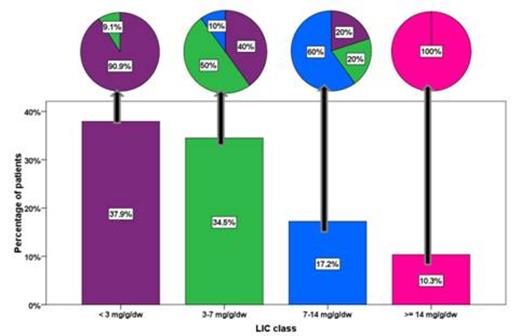Abstract
Background. In thalassemia intermedia (TI) patients no observational study prospectively evaluated in the real life the efficacy of the desferrioxamine (DFO) therapy in removing or preventing iron overload from the heart and the liver by T2* Magnetic Resonance Imaging (MRI). The efficacy endpoint of this study is represented by the changes in cardiac T2* and MRI LIC (liver iron concentration) values in non-transfusion dependent (NTD) TI patients after 18 months of desferrioxamine therapy.
Methods. Among the 325 TI patients enrolled in the MIOT (Myocardial Iron Overload in Thalassemia) network, we selected 129 TI patients NTD. We considered 29 patients who had been received DFO alone between the two MRI scans. Cardiac iron overload was assessed by the T2* multiecho technique. Hepatic T2* values were converted into liver iron concentration (LIC) values.
Results. Mean age was 39.69 ± 8.12 years and 14 (48.3%) patients were females. Patients started regular chelation therapy at a mean age of 21.92 ± 15.89 years. The mean administered dosage of DFO via subcutaneous route was 38.46 ± 10.27 mg/kg body weight on 3.32 ± 1.54 days/week. The percentage of patients with excellent/good levels of compliance to the chelation treatment was 82.1%.
At baseline only one patient showed cardiac iron overload (global heart T2*=15.23 ms) but he recovered at the FU (global heart T2*=26.93 ms). All patients without cardiac iron maintained the same status at the follow-up (FU).
Eighteen patients (62.1%) had hepatic iron overload (MRI LIC ≥3 mg/g/dw) at the baseline.
For this subgroup, the baseline and the FU LIC values were, respectively, 9.15 ± 7.97 mg/g/dw and 7.41 ± 6.28 mg/g/dw. The reduction in MRI LIC values was not significant (P=0.102). Out of the 11 patients with a baseline MRI LIC <3 mg/g/dw, only one (9.1%) showed hepatic iron at the FU. The Figure shows the evolution of different hepatic iron overload risk classes between the baseline and the FU.
Conclusions. In this small population of sporadically or non transfused TI patients, DFO showed 100% efficacy in maintaining a normal global heart T2* value. As regards as the hepatic iron overload, the DFO therapy did not prevent the transition to a worst class in 2 patients.
Pepe:Chiesi: Speakers Bureau; ApoPharma Inc.: Speakers Bureau; Novartis: Speakers Bureau.
Author notes
Asterisk with author names denotes non-ASH members.


This feature is available to Subscribers Only
Sign In or Create an Account Close Modal